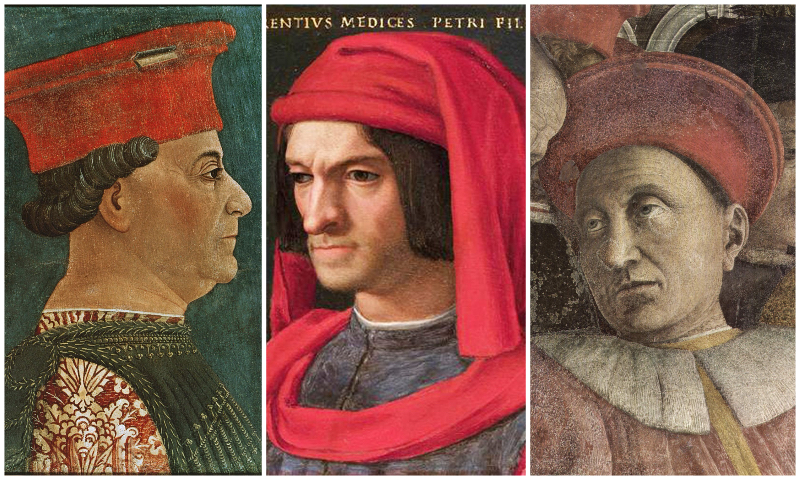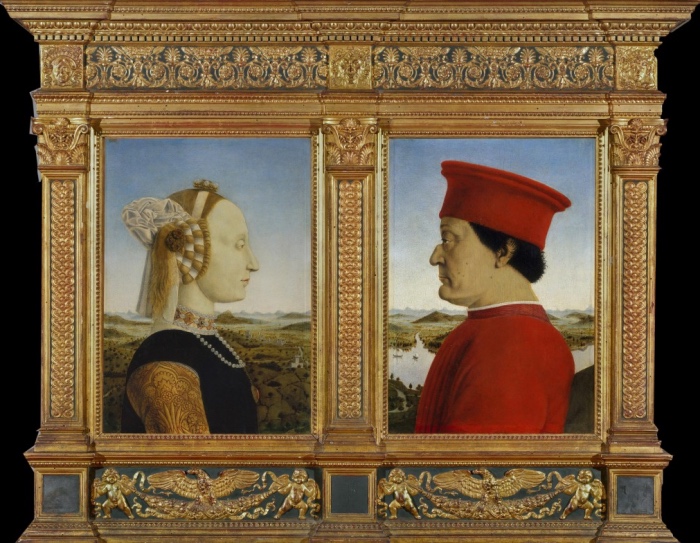
Francesco Sforza, Lorenzo de’ Medici, Ludovico III Gonzaga
Between the mid 15th century and the early 16th century, Italy witnessed the blossoming of a unique relationship between lords and artists that would profoundly mark the Renaissance. In this period of intense creativity and innovation, patrons were not mere patrons, but real cultural promoters who shaped cities as stages for their artistic and political ambitions. Artists resided in noble palaces, immersed in a stimulating intellectual environment, collaborating with humanists, philosophers, poets and scientists. This symbiosis gave rise to timeless masterpieces and monumental architectural works celebrating the greatness of their patrons.
In this post, I take you on a discovery of the lords of the Italian Renaissance courts.
PATRONS OF THE RENAISSANCE

I duchi di Urbino. Image source: Cacciatrici di Paesaggi. com
Between the mid-15th and early 16th century, a new type of relationship between the lord and the artist became established.
The artist often resides in the palace and has an inconstant relationship not only with the lord who protects and supports him but also with other intellectual figures present at court (humanists, men of letters, philosophers, poets, musicians, mathematicians), who increase his cultural background.
The artist’s task is the care of the lord’s image, intervening with works to be placed within the court but also in the city and in the territory in which his lord’s power extends. the city is therefore conceived as a stage and also as a showcase of the prince’s qualities and abilities.
The artist is therefore maintained and salaried by the lord and works exclusively for his master, dedicating himself not only to the creation of works of art but also to the design and staging of monumental undertakings and more ephemeral apparatuses, such as stage sets and costumes for ceremonies, theatre performances, weddings, parties, funerals of court figures or for prestigious guests.
The gallery of the Lords of Italy who supported the artists between the mid-15th and early 16th century is numerous, as the fragmented political geography of Italy is characterised precisely by a multiplicity of states and powerful personalities.
However, if we have to select the main lords and patrons of this period, I can identify seven of them.
FRANCESCO SFORZA
Francesco Sforza (1401-1466) Duke of Milan from 1450 was the main promoter of the Peace of Lodi and fostered the political, economic and artistic revival of the Duchy of Milan.
LORENZO DE’ MEDICI
Lorenzo de’ Medici (1449-1492), lord of Florence from 1469, is the symbolic figure of the Florentine Renaissance. Writer, poet, patron, humanist prince and great politician, he protected the greatest artists of his time throughout his life.
LUDOVICO III GONZAGA
Ludovico III Gonzaga (1412-1478), Marquis of Mantua from 1444, was the refined humanist under whose leadership Mantua became one of the capitals of the Italian Renaissance.
FEDERICO DA MONTEFELTRO
Federico da Montefeltro (1422-1482), Duke of Urbino in 1474, is the one who wanted and strongly desired the building of the ducal palace in Urbino, investing the numerous earnings obtained from his military career and calling upon the best artists of the time to realise this work that we can still admire today. Federico da Montefeltro is also the commissioner and protagonist of the Brera Altarpiece by Piero della Francesca.
SISTO IV DELLA ROVERE
Pope Sixtus IV (1414-1484) was the Pope of the Catholic Church in 1471. He is the promoter of major building and town-planning interventions in Rome and it was he who had the Sistine Chapel built.
ALFONSO D’ARAGONA
Alfonso of Aragon (1396-1458) was the Spanish prince and king of Naples from 1442. His policy of strong patronage transformed the Neapolitan court into an important European cultural centre.
SIGISMONDO PANDOLFO MALATESTA
Sigismondo Malatesta (1417-1468) and lord of Rimini in 1432 and patron of the arts at his court. He summoned artists and men of letters, who brought prestige to the entire city.

Federico da Montefeltro, Sisto IV della Rovere, Alfonso d’Aragona, Sigismondo Pandolfo Malatesta
The Italian Renaissance was an era of extraordinary cultural and artistic flourishing, made possible thanks to the vision and support of the great patrons of the time. These men not only financed works of art and monumental projects, but also created an environment in which artists could express their genius freely and innovatively.
These lords transformed their cities into pulsating centres of culture, where beauty and ingenuity were at the service of prestige and politics. Their courts became forges of ideas, where art intertwined with philosophy, science and literature, giving rise to a unique era of creativity and progress.
Today, their legacy lives on in the works we can admire in museums, churches and palaces throughout Italy. The patrons of the Renaissance teach us the value of culture and art as instruments of personal and collective elevation, demonstrating how the support of artistic talents can produce masterpieces destined to last for centuries. Looking back at this period of splendour, we can find inspiration to promote and enhance the arts also in our time, keeping the spirit of the Renaissance alive.

